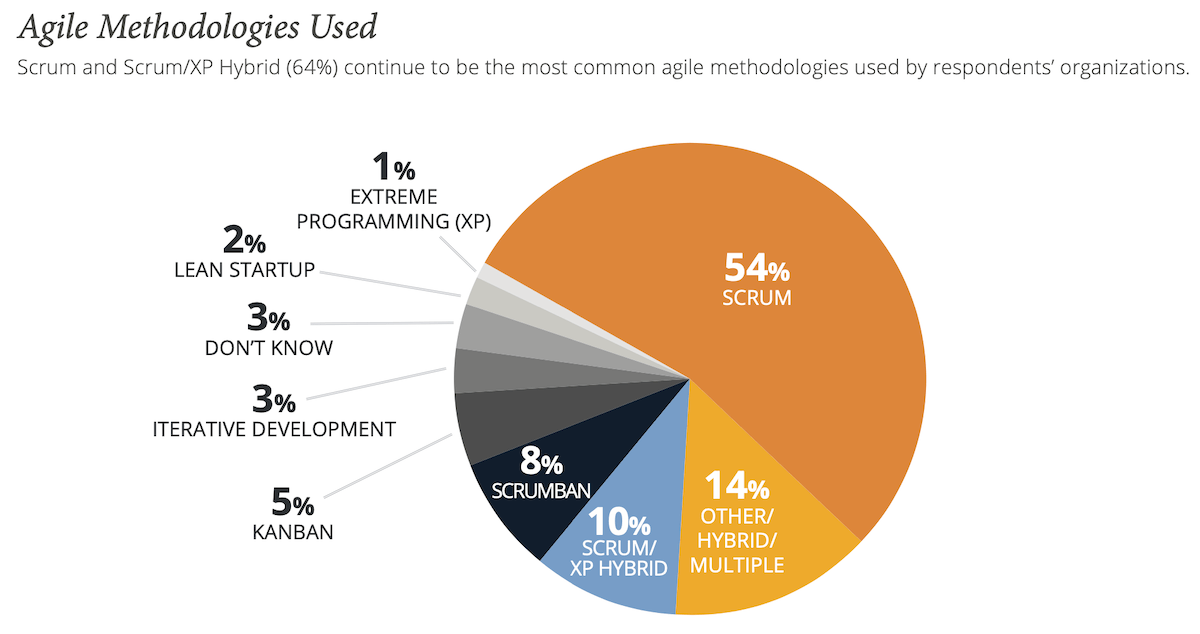In this article, we will give all the details about the Agile Project Management and Scrum Master Certification Online options. But first, let’s have a look at what is Agile, how and why it became a trend?
Hint: Do not skip the post. You will see links to the free scrum master online course as well!
Scrum Master Certification Online – Why Agile?
If you are a follower of technology trends, then you must have heard about Agile project management before. Agile project management is trending since the 2000s. It came to light when software development started to face challenging situations; where waterfall project management failed to deliver the changing needs of the industry. At this time, software development organizations needed new practices to help organizations keep up with the ever-changing dynamics of software technology. Thus, organizations started to look for rapid project delivery, quick outcomes, and agility to adapt to ever-changing requirements. This changing environment changed the project management world as well. Instead of waterfall project management, where you plan everything ahead then execute, organizations opt for delivering projects in increments and welcoming changing requirements throughout the project. Agile practices started to emerge in the 90s however, it only started to trend following a meeting that took place in 2001. See the best Scrum Master Course Online options.
The 2001 meeting where a group of software development professionals sit and discussed Agile practices concluded with the Agile Manifesto. This manifesto outlined the key core values of Agile practices. Later on, the authors of the Agile Manifesto expanded the core values to develop the Agile principles. These 12 principles combined sets the foundation for the Agile mindset. The formulation of the Agile manifesto and the following Agile principles shifted the grid of project delivery within software development.
Check our Agile for Beginners Training Video
Following the success of Agile practices and applications within the software development industry, the trend started to spread to other similar industries which lead to the widespread of Agile practices. These practices and methodologies helped organizations reduce their expenditure waste and increase the quality of their outputs.
The Agile Manifesto
The 2001 meeting came out with some values which later on evolved to what is known today as the Agile manifesto. The Agile manifesto represents the core values that form the heart of the Agile. These values spread to inspire the 12 known Agile principles. According to the Agile manifesto, Agile is a mindset, not a methodology. Thus it is important to think of the Agile as a philosophy rather than tools, processes, and technologies. By understanding the values and principles of Agile, you automatically unlock your mental locks and restrictions. You become more bound with results than process. This does not mean that you are completely free of planning or loose thinking without any constraints. On the contrary, Agile still depends on planning as well but not the same way as the waterfall. Agile focuses on realistic planning rather than extensive forecasting and excessive estimating techniques.
Within Agile planning, techniques are used to optimize Agile teams’ work rather than forcing them to commit to unrealistic deadlines. Also, Agile planning techniques focus on the short term planning with the concept of “planning what we know” rather than planning for everything ahead. This means that Agile planning refrains from putting assumptions and focuses heavily on actual. Still, it is worth mentioning that Agile is not the cure for every problem. The waterfall still has its own advantages with straight forward deliveries and well-known projects. But what we are trying to say here is that Agile is the solution for the problems of limited resources, the unclear scope of work, new technologies, etc. It may seem flashy words but it is not. Agile rapidly gained popularity among multiple industries and applications. This especially applies to new technologies and new trends like digital transformation, robotics, the Internet of things, etc.

Agile Values
So what are the Agile core values and how they contribute to the build-up to the Agile mindset? As we explained Agile is a mindset, to solidify this mindset, Agile focuses on 4 main values:
-
Individuals and interactions over processes and tools
This value focuses on the importance of interactions between different members of the Agile team and other key players in Agile over sticking to processes and tools. The purpose of this value is to embrace the value of people’s interaction over the routine that some processes and tools may impose. It is not meant to disregard processes completely. But it emphasizes on validating that these processes actually help the project to move forward and contribute to the overall project goal by making sure that people are collaborating towards building a working product. This can be achieved by involving the customer and project team in decision making. Creating an open feedback loop that allows customer feedback to flow to the team in time to improve the product with less waste. It also allows the team to improve through interacting with different people in the project and increase the project trust level.
-
Working software over comprehensive documentation
The key purpose behind this value is to focus on delivering a working product than creating extensive documents to describe the product. The objective of any project whether Agile or waterfall is to provide an end product that satisfies the customer needs. Many methodologies and approaches focus more on documenting every single detail about the product. On the other hand, the Agile approach is more focused on creating a working product. But this does not mean disregarding documentation completely. Rather, it makes sure the project team is not spending most of their efforts and time trying to capture documentation.
-
Customer collaboration over contract negotiation
This value is focused on building trust and relationship with the customer rather than focusing on making the relationship formal. Collaboration is the key. Agile focuses on making the customer a partner in the product buildup, not just an approval point. The customer relationship is not just bound by the signed contract but rather with collaboration towards the successful delivery of a working product. Accordingly, the Agile team has to have this collaboration mindset, thinking of the customer as a success partner not as a buyer bound with a contract.
-
Responding to change over following a plan
Agile does not mean improvising all the way and work randomly without any planning. The value of responding to change embraces the fact that as much as planning is important, it is still not the ending goal of a project. Planning techniques and artifacts are the means of helping project managers, scrum masters, and product owners to improve the results of their projects.
So what happens when it doesn’t serve this purpose? You should stop following the part of the plan that wouldn’t. So how to do it? Normally when you have this straightforward project with little room for unknown risks and a low level of uncertainty, planning becomes easier and changes become less frequent. Thus, in waterfall projects sticking to the plan is a clear cut way to achieve the project objective. So what happens when there is a high level of uncertainty? Yes, you should expect a high frequency of changes.
If you decide to follow a detailed plan for an ambiguous project, you will definitely have to set assumptions. In return, these will turn either to be true in many cases or false in other instances. These assumptions are just a projection of what you and your team originally though is the right way to do it.
However, when you start to implement this way and test the validity of your plan, it usually turns out to be at least a little bit different. In waterfall, since these changes are usually few, implementing a change management process will help you improve the outcome. When a project is ambiguous, changes are frequent, since no one knows the best way to develop the product. Accordingly, this requires more than just managing changes but focus on how to respond to these changes and consider them in the ending product.
Agile Principles
So if we consider Agile values as the heart of the Agile, Agile principles are the hands. The Agile principles complement the Agile core values, these principles are:
- Our highest priority is to satisfy the customer through early and continuous delivery of valuable software.
- Welcome changing requirements, even late in development. Agile processes harness change for the customer’s competitive advantage.
- Deliver working software frequently, from a couple of weeks to a couple of months, with a preference to the shorter timescale.
- Business people and developers must work together daily throughout the project.
- Build projects around motivated individuals. Give them the environment and support they need, and trust them to get the job done.
- The most efficient and effective method of conveying information to and within a development team is face-to-face conversation.
- Working software is the primary measure of progress.
- Agile processes promote sustainable development. The sponsors, developers, and users should be able to maintain a constant pace indefinitely.
- Continuous attention to technical excellence and good design enhances agility.
- Simplicity–the art of maximizing the amount of work not done–is essential.
- The best architectures, requirements, and designs emerge from self-organizing teams.
- At regular intervals, the team reflects on how to become more effective, then tunes and adjusts its behavior accordingly.
These principles combined with values act as the main outline and guidelines for all agile different practices, applications, and methodologies
Agile Practices
There are a number of Agile practices and methodologies available for study and application out there. These practices and methodologies including Kanban, XP, and hybrid, etc. However, the Scrum framework is the most popular Agile project management methodology and that’s why we will be going over different Scrum Master certification online options and Scrum Master online training options in this post. Due to the widespread of Agile methodologies in almost all industries, there’s an increasing demand for Agile trained project managers. Thus, the demand for Scrum Master Certified professionals and other Agile Certified professionals increased as well. Accordingly, more and more professionals are looking for Scrum Master Certification Online.
Scrum
This methodology and its associated Scrum Master Certification is the dominant Agile methodology when it comes to popularity. The Agile methodology and practice focus on the frequent delivery of product increments. It also focuses on building strong, dedicated Scrum teams that work together for an elongated period of time, moving together from one project to another. See the best Scrum Master Course Online options.
Through this practice, the Scrum team achieves a long-lasting state of the team performing stage, which the organization can benefit from in the long term and short term. Also, Scrum capitalizes on the concept of continuous customer feedback by involving customers in frequent forums to solicit his feedback. Thus it avoids false directions as early as possible.
Attend our FREE Scrum Master Online Course.
XP -Extreme Programming
XP is another Agile methodology that is mainly software-driven practices that revolve around a similar basis to Scrum.
Extreme Programming involves 5 simple rules which in turn are based on 5 main values:
- Communication: Throughout the project, each team member works collaboratively with the rest of the project team.
- Simplicity: Designers and programmers challenge themselves to do the work in the simplest way possible for the product. This saves time and effort, also it makes it easier for others to understand.
- Feedback: Deliver software features more frequently and solicit customer feedback, then improve your product accordingly.
- Respect: All project team members are committed to shared goals and respect for each other.
- Courage: Objectively assess your work and avoid making excuses, always be ready to respond to changes.
Kanban
This Agile methodology is a workflow-driven practice that focuses on prioritizing project work and getting the work done accordingly. Kanban practice proves to be successful whenever there is some limitation of talents available for the project as well as, the case where there is a physical resource limitation. Kanban is a Lean technique and follows both Agile and Lean principles.

Hybrid
It is the practice of using more than one project management practice to approach a project. This optimally happens when the project contains multiple components that are not with the same nature. This may include a waterfall approach and an Agile approach or two different Agile approaches. An example of hybrid project delivery is when a company works on installing a new system that requires connectivity and hardware setup. In this case, the system development could involve a Scrum or Kanban approach, while the hardware setup follows the waterfall approach.
Scrum Master Certification Online
As we explained before, there are several methodologies and frameworks in Agile Project Management. However, Scrum is the most popular and most used framework by several organizations around the world. Based on the 13th annual State of Agile survey, 64% of the participants’ organizations use Scrum and Scrum/XP Hybrid.

Scrum Popularity
This is the main reason why Scrum Master Certification Online options become more and more popular. Organizations look for certified Agile project management professionals to employ in their Agile vacancies. Scrum master certification becomes a vital asset if you are willing to have a Scrum role in an organization. The popularity of Scrum Master Certification Online increased dramatically due to its simple and effective approach. Accordingly, the mainstream Agile community is majorly focused on Scrum.
So what is Scrum? Scrum is an incremental project development approach that works on using time-boxed intervals to produce project product increments. The key concept about Scrum is to focus on delivering small but focused features rather than planning the entire project delivery. Thus, allowing the Scrum team to deliver more frequently and take feedback in short intervals. In other words, Scrum divides projects into sprints each sprint is with the same period.
This period ranges from 1 to 4 weeks, however in all cases, project sprints must have a fixed period. This means that if a project consists of 10 sprints all the sprints must be with the same exact period, for example, 2 weeks for each sprint. This helps the Scrum team to focus on a small number of features in each sprint, considering that during sprint running features cannot be changed until the next sprint.
Attend our FREE Scrum Master Online Training.
So what are the benefits out of this you say? Scrum helps the Scrum team to focus on delivering the best working features and deliver additional features more frequently. Also, Scrum helps the Scrum team to collect customer feedback more frequently than phased projects. Thus it improves upcoming products’ features as early as possible. Also, Scrum teams tend to work together for a long time which leads to improved teamwork, higher productivity, and better quality of outputs.
#1 Scrum Master Certification – PMI-ACP
Perhaps the most accepted Scrum Master Certification among different Scrum Master Certifications is the Agile certification of PMI. Supported by the reputation of the Project Management Institute, ACP stands as one of the widely accepted and favored Scrum Master Certification. The reason behind this Scrum Master Certification’ popularity, is the appeal that Agile Certified Practitioner certification or in short ACP offers. PMI Agile Certified Practitioner certification offers a holistic practice that takes into consideration the different types, nature, and environment of projects.
Accordingly, unlike the rest of other Scrum Master Certifications, PMI-ACP does not offer one size fits all approach. But rather, it focuses on identifying the project development life cycle and the environment surrounding the project to decide the right approach for this project. Hence it increases the versatility of project manager/ Scrum master while managing different types of projects. It allows project managers to manage each project in a way that fits it.
Despite the appeal of PMI Agile Certified Practitioner certification, this Scrum Master Certification is not easy to acquire. PMI depends on an integrated accreditation system that examines the certification holders’ qualifications according to 3 main verticals. These verticals are education, knowledge, and experience. Thus, PMI sets prerequisite requirements that you must achieve in order to earn PMI-ACP.
PMI-ACP requirements
The requirements for this Scrum Master Certification are the following:
- Education: The first qualification for this Scrum Master Certification having at least Secondary degree education
- Experience; there’s also a specific level of project experience required for this Scrum Master Certification which includes the following two sub-requirements:
- 12 months of general project experience within the last 5 years.
- 8 months of Agile project experience within the last 3 years
A current PMP® or PgMP® will satisfy the 12 months of general project experience requirement but is not mandatory to apply for the PMI-ACP.
3. The third and last requirement is PMI-ACP training that will earn you 21 contact hours.
Achieving those three requirements won’t grant you this Scrum Master Certification by default but rather it will grant you a seat for taking the PMI ACP exam.
You can attend our PMI-ACP course to be eligible to sit in the PMI-ACP Exam.
#2 Scrum Master Certification – PSM from Scrum.org
The second Scrum Master Certification we are exploring today is Professional Scrum Master (PSM) certification. Professional Scrum Master (PSM) certification is a Scrum Master Certification offered by Scrum.org. This Scrum Master Certification strictly follows the Scrum methodology we have explained earlier. Thus, those who wish to achieve this Scrum Master Certification is required to sit for a Scrum Master Certification online test.
The test challenges your understanding of the Scrum core concepts and terminologies. On the other hand, This Scrum Master Certification online does not require any prerequisite in terms of education or experience requirements. Thus, anyone who books, sits, and passes the exam will earn the certification. Also, this Scrum Master Certification online offers three levels; to earn an advanced level you have to pass the level prior to it.
On the popularity level, PSM from Scrum.org is considered as one of the most recognized Scrum Master Certification globally. This gives the certificate high credibility and makes it one of the most demanded Scrum Master Certification. Although its cost is relatively lower than its peer Scrum Master Certification, it still maintains high status.
Also, despite offering online training, Scrum.org does not mandate training as a prerequisite for any of the Professional Scrum Master (PSM) certification levels which makes it even more appealing. But there are many high-quality providers who offer Scrum Master Certification Online training. Thus this makes it a value add for this Scrum Master Certification.
You can attend our PSM online training to get ready for the PSM certification.
#3 Scrum Master Certification – CSM from Scrum Alliance
CSM (Certified Scrum Master) is another popular Scrum master certification online option globally. Certified Scrum Master is a Scrum master certification offered by Scrum Alliance. It’s considered as one of the most demanded Scrum master certifications all over the globe and its holders are attributed to the best practices of Scrum.
Much like the Professional Scrum Master certification offered by Scrum.org, CSM strictly follows Scrum practice. Thus, its holder must showcase her/his adoption and understanding of the Scrum concepts and terminologies. Despite the similarities between the two Scrum master certifications, CSM has prerequisite requirements for any person aspiring to earn it. These requirements involve attending a classroom or online CSM training provided by a Certified Scrum Trainer® (CST®). Once you complete the training, you can sit for the exam where you need to score at least 37 out of the 50.
Alternatively, you can obtain coaching from a Certified Agile Coach privately, then take the exam with the same conditions. Another note worth mentioning is that CSM requires renewal every two years by earning Scrum Education Units® (Scrum SEUs).
Attend our CSM training and get ready for the CSM exam.
Advanced Scrum Master certification from Scrum Alliance
Obtaining the certificate is only the start of a long journey of Scrum pathway, similar to Scrum.org, Scrum alliance offers advanced levels. So those who successfully obtained CSM can pursue and advanced Certified Scrum Master certification. This scrum master certification is called Advanced Certified Scrum Master or (A-CSM). A-CSM also has its own perquisites that include obtaining CSM first, secondly attend a certified A-CSM educational session; then complete all the assignments assigned to you by the coach/ trainer. Finally, you have to have a valid work track record of 12 months working as a Scrum master within the past five years.
The next level to this track is achieving the highest Scrum master certification, and this certification is Certified Scrum Professional®-Scrum Master or in short CSP. Similar to its predecessors this Scrum master certification online requires obtaining A-CSM and CSM before sitting for its exam. Also, it requires attending CSP educational sessions as well as having a valid work track record of 24 months working as a Scrum master within the past five years. Similar to CSM and A-CSM, CSP also requires renewal every two years by earning Scrum Education Units® (SEUs).

CSM Renewal
As we mentioned earlier all three Scrum master certifications that Scrum Alliance offers require renewal every two years. Accordingly, the Scrum Alliance certificate holder must work towards earning the required SEUs before the end of the certification cycle. The renewal process is explained in an article we have published before, you can access this article from the following link Scrum Alliance certification renewal.
SEUs can be collected through continuous learning in the Agile methodologies. The purpose of collecting these SEUs is to ensure your continuous development in Agile in general and Scrum in specific. Thus SEUs are bound with many learning programs. Scrum Alliance provides these programs but it also allows you to include other programs outside its SEUs offerings. Once you collect the SEUs you can report them through the Scrum Alliance portal. Then upon completing required Scrum Master certification SEUs collection you can renew your certification.
You can collect SEUs in multiple ways, this includes formal Agile education, attending Agile practice events, webinars. In addition to these, there are other ways to collect SEUs and many of these ways are free. We will list them in the Scrum master certification free options section. On the other hand, obtaining SEUs is not the only way for Scrum master certification renewal. Scrum Alliance also grant automatic renewal to certification holders who obtain another Scrum Alliance Scrum Master certification. These certifications not only include Scrum Master certification higher levels. But they also include other certifications that Scrum Alliance provides like CSPO for example.
Besides these two options, the Scrum Alliance also allows you to renew your Scrum Master certification through paying administration renewal fees. This option comes in handy for those who find it hard to track their development activities and prefer to pay instead for their certification renewal.
Free CSM renewal options
Scrum Alliance also offers other free options for you to renew your Scrum Alliance Scrum Master certification. Almost every Agile learning and development activity you may do, Scrum Alliance would count within SEUs. Any activity that you may think of like reading a book about Scrum or Agile practices and methodologies might earn you SEUs. This can also be reading a blog or article which discusses Agile values, principles, practices, frameworks, tools, and techniques, or artifacts.
Additionally, if you contribute to Agile content delivery or development you can report it to collect your SEUs. Also, Agile workshops, learning, sessions within your workplace counts as well. If you attend a live or online webinar that discusses Agile practices or trends, artifacts, etc. This may also include watching a recorded Agile practice webinar or event.
Learning through watching Scrum or Agile videos also counts as SEUs for Scrum Master certification renewal. In addition to the previous options, you may also participate in a Scrum or Agile coaching program either as a mentor or student. With all of these options and any learning or development option that may come to your mind, you can collect the required SEUs for your Scrum Master certification renewal. See our Free Scrum SEU Bundle course.
#4 Scrum Master Certification – Certified SAFe Agilist from Scaled Agile
Moving to a different category of Scrum Master Certification we are going to discuss the Scaled Agile framework. Scaled Agile is more popular with organizational Agile transformation and enterprise Agile frameworks. They offer several certification tracks. Leading SAFe training is the most popular Scrum master certification online option from Scaled Agile.
Once you attend Leading SAFe training, and sit for the exam, if you pass, you will earn the Certified SAFe Agilist designation. SAFe offers a wide range of certifications that covers every possible aspect of Agile project management and organization related program management, portfolio management, etc. SAFe works as an integrated hybrid approach to scaled and mega Agile projects. Since Scrum focuses mainly on delivering small increments frequently, it’s difficult to scale the work using an existing Scrum structure. Especially if you consider the fact that Scrum does not allow teams to grow beyond 9 members and the fact that Scrum teams must focus on one feature at a time. Thus, large deliveries seem an impossible task in the short term with these restrictions applied.
This is where SAFe comes in motion to tackle this issue. Scaled Agile incorporates different Agile practices together to serve in a bigger picture. Thus, SAFe employees Scrum as one of the workstreams intended to help deliver a scaled program. SAFe offers a Scrum master certification foundation level in the form of Certified SAFe® Agilist. Certified SAFe® Agilist recognizes a corporate professional leader who contributes to Lean-Agile transformation. This Scrum Master certification has a prerequisite of attending the Leading SAFe® course. Following the course, you must pass the certification exam by scoring 35 out of 45 (77%).
Attend our Leading SAFe – Certified Agilist Course.
#5 Scrum Master Certification – Advanced Level Certifications
We have mentioned before that some of the mentioned Scrum Master Certification options have advanced level certifications. We have detailed the advanced levels for Professional Scrum Master which includes PSM II and PSM III. We’ve also explained the advanced levels for Certified Scrum master CSM which includes A-CSM and CSP. Also, we went through the prerequisites for each of these levels.
Now we can also go through advanced Scrum Master Certification options for Scaled Agile as well. Scaled Agile foundation level certification is Certified SAFe® Agilist. The next level to this certification offered through SAFe is Certified SAFe® Scrum Master. This Scrum Master Certification is designated to recognize Scrum and Kanban methodologies program execution mastery. Also, Certified SAFe® Scrum Master has its own set of perquisites which involves attending the SAFe® Scrum Master course. Following the course, you must pass the certification exam by scoring 34 out of 45 (75%).
Once you pass the exam, congratulations you are now a Certified SAFe® Scrum Master! In addition to SAFe® Scrum Master certification, Scaled Agile offers another advanced level for SAFe. This SAFe Scrum Master certification is Certified SAFe® Advanced Scrum Master which recognizes Scrum masters with advanced skills. These skills involve improving the overall results of the teams through cross-team interactions and continuous improvement facilitation.
Scrum Master Online Training
Now that you have the full picture and overview of Scrum Master Certification, we can go through the training requirements. Each of the discussed Scrum Master Certification has its own Scrum Master Online Training requirements. In the following section, we will walk you through the details and specifics of each Scrum Master Certification. So we will explain whether each of these Scrum Master Certification requires training as a mandatory requirement or not. Now that we are set to go, let’s start our journey through Scrum Master Online Training.
Scrum Master Online Training for PMI-ACP Certification
This is Project Management Institution’s Scrum Master certification, Agile Certified Practitioner, or in short PMI – ACP. As we mentioned in the earlier sections of this post PMI – ACP requirements for candidates. Candidates must fulfill these requirements before PMI approves their application. In terms of Scrum Master Online Training, PMI mandates its candidates to attend 21 hours of Agile education training. This is a no escape ticket deal! If you are planning to obtain PMI – ACP, you must attend this Scrum Master Online Training. Then afterward you take the exam and pass. On the other hand, this Scrum Master Online Training must cover basic Agile outlined concepts and practices.
Scrum Master Online Training for PSM Certification
Professional Scrum Master certification PSM provided by Scrum. org does not require Scrum Master Online Training as an exam prerequisite. Thus if you are planning to obtain this Scrum Master certification you are not obliged to take any Scrum Master Online Training. However, it is highly recommended that you attend a Scrum Master Online Training. So you can understand the key concepts of Agile and practices before heading to the exam. Going to the exam without preparation in most of the cases makes your success opportunity at high risk.
Scrum Master Online Training for CSM Certification
The Scrum Alliance’s Scrum Master certification requires that you must attend a two-day CSM training so you can be eligible to earn CSM certification. This training walks you through the key concepts and basics of Scrum practices. Following the training, you can take the CSM exam in order to pass the CSM exam.
Scrum Master Online Training for Certified SAFe Agilist and Scrum Master Certification
If you decide to pursue Certified SAFe Agilist or SAFe Scrum Master Certification you need to understand that there is training required. Scaled Agile mandates that you must attend a two-day Leading SAFe training to be eligible to sit for the exam. Upon passing the exam, you will be earning Certified SAFe Agilist certification or SAFe Scrum Master Certification. The required Scrum Master Online Training is also a great value add to its attendees as it walks them through the concepts of SAFe.
Summary – Scrum Master Certification Online
We have introduced you to the history of Agile and how it came to the scene of the global business as a solution for a long-lasting issue. This long-lasting issue was dealing with the dynamics of the ever-changing technology environment. Also, we have walked you through the key concepts of Agile and Scrum practices.
We also explained the different Scrum Master Certification options including PMI-ACP Certification and Professional Scrum Master certification (PSM). Then, we have explored the certified Scrum Master certification and its associated details. In addition, we have explored Certified SAFe Agilist certification provided by the Scaled Agile Framework. On the other hand, we been through the advanced levels of each Scrum Master certification. This included PSM II and PSM III Scrum Master certification which is the higher level for PSM certification offered by Scrum.org.
Attend our FREE Scrum Master Online Course.
Then in the third section of this article, we have explored the requirements for each Scrum Master certification focusing on the Scrum Master Online Training requirement for each of these certifications. Accordingly, you now have the proper knowledge of what you need to do in order to pursue any of these Scrum Master certifications. But in all cases, we advise you to have proper Scrum Master certification online before taking any Scrum Master certification exam. The reason as we explained is that it offers you the proper knowledge you need to understand the core concept of Scrum. This recommendation comes from the experience of Scrum Master certification takers who preceded you.
Generally, Scrum concepts are simple enough for you to understand, however, its simplicity doesn’t mean that you can understand them on your own. Since many of these concepts are unique to Agile in general and Scrum in specific.






